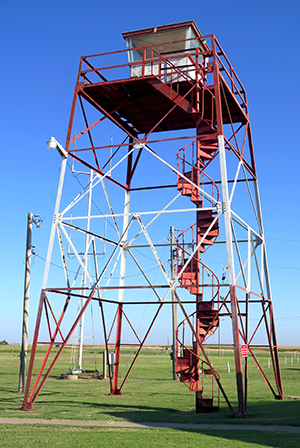by Jim Bildilli
Published in Midwest Flyer Magazine – December 2021/January 2022 Online Issue
 About half-way across Kansas, if you’re VFR and following I-70 or the old National Road (U.S. 40), you’ll eventually come across the town of Russell, Kansas. Some of us with graying and possibly thinning hair remember the town as the home of former senator and presidential candidate, Robert (Bob) Dole. In many locations around the country, the airports sometimes reflect the influence of a local famous politician, but the Russell municipal airport is very typical of a small-town airport that you’d find most anywhere in the U.S. It currently features a 5000 x 75 ft. north-south concrete runway, and a 1600 x 300 ft. northeast-southwest turf runway. With GPS approaches to Runway 17-35, major airframe and powerplant repairs and 24-hour fuel, it’s a nice place to stop while traveling across the country. Like most small general aviation airports, there’s no restaurant, although there is a courtesy car to make the short trip into town for a bite to eat or perhaps to conduct a little business.
About half-way across Kansas, if you’re VFR and following I-70 or the old National Road (U.S. 40), you’ll eventually come across the town of Russell, Kansas. Some of us with graying and possibly thinning hair remember the town as the home of former senator and presidential candidate, Robert (Bob) Dole. In many locations around the country, the airports sometimes reflect the influence of a local famous politician, but the Russell municipal airport is very typical of a small-town airport that you’d find most anywhere in the U.S. It currently features a 5000 x 75 ft. north-south concrete runway, and a 1600 x 300 ft. northeast-southwest turf runway. With GPS approaches to Runway 17-35, major airframe and powerplant repairs and 24-hour fuel, it’s a nice place to stop while traveling across the country. Like most small general aviation airports, there’s no restaurant, although there is a courtesy car to make the short trip into town for a bite to eat or perhaps to conduct a little business.
When taxiing to the ramp, there is one structure that absolutely gets your attention. It’s a 32 ft. high steel tower that is reminiscent of a short forest ranger tower that you would usually find near a national forest. However, this is not a forest ranger tower… it’s a tower that was constructed and used in the mid-1940s and early 1950s as an enemy aircraft spotting tower.
Radar coverage in the northern hemisphere had not been developed then to the point where there was wide-area coverage to intercept incoming Russian bombers on their way to wreak havoc on American cities with their new atomic bombs. Most of the towers were placed in less populated areas in the U.S. based on the belief that the Russians would avoid being spotted as easily, than if they flew over large population centers on the east and west coasts.
The tower supports an all-glass cab that was sparsely adorned with a countertop. Other than that, the other essentials included maps, binoculars, a location code, and a telephone to contact the Air Defense Filter Center which was located in Hutchinson, Kansas.
The spotting towers, of which few remain today, were staffed 24-7 by trained local volunteers that even included high school students. The ground observers training manual was published by the U.S. Air Force and contained pictures identifying both American and foreign aircraft. The spotters received a certificate of completion and a keepsake lapel pin to celebrate their accomplishment.
The historical observation tower, which was originally donated by the Shield Drilling Co. in late 1944, remains today, thanks to the restoration efforts of EAA chapter members, Phillip Schulz and Wayne Luff, both of whom have since gone west. Unfortunately, if you are looking forward to climbing the 48-step spiral stairway to the top, access is no longer permitted.